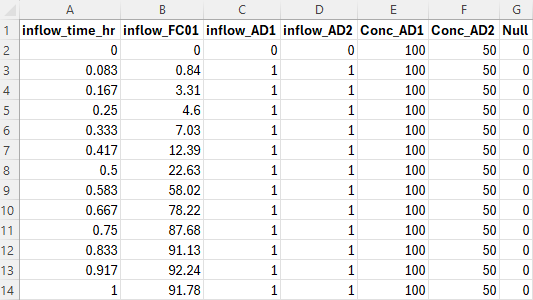Difference between revisions of "Advection Dispersion Modelling"
Tuflowduncan (talk | contribs) |
|||
| Line 1: | Line 1: | ||
=Introduction= | =Introduction= | ||
| − | TUFLOW’s Advection Dispersion (AD) Module is an extension of the TUFLOW Classic/HPC engines. It | + | TUFLOW’s Advection Dispersion (AD) Module is an extension of the TUFLOW Classic/HPC engines. It adds tot he hydrodynamic capabilities of TUFLOW Classic/HPC by simulating depth-averaged, two and one-dimensional constituent fate and transport. An example of such a constituent might include salinity. Both dissolved and particulate constituents can be simulated. TUFLOW AD takes depth and velocity fields computed by the TUFLOW Classic and HPC solvers and uses this information, together with initial and boundary conditions, to simulate the advection and dispersion of user-defined constituents. |
| − | TUFLOW AD is specifically oriented towards such analyses in systems including coastal waters, estuaries, rivers, floodplains and urban areas. The AD module is discussed in the TUFLOW Advection Dispersion Manual. | + | TUFLOW AD is specifically oriented towards such analyses in systems including coastal waters, estuaries, rivers, floodplains and urban areas. The AD module is discussed in detail in the TUFLOW Advection Dispersion Manual. |
=Model Development= | =Model Development= | ||
==Setting Up a New Model== | ==Setting Up a New Model== | ||
| − | The steps below describe the process for setting up a TUFLOW AD model. It is assumed that the user is familiar with TUFLOW and that the folder structure for TUFLOW has been setup with all required files. The user should run the TUFLOW model without the AD module first to make sure that it is appropriately configured and stable. | + | The steps below describe the process for setting up a TUFLOW AD model. It is assumed that the user is familiar with TUFLOW Classic/HPC and that the folder structure for TUFLOW has been setup with all required files. The user should run the TUFLOW Classic/HPC model without the AD module first to make sure that it is appropriately configured and stable. |
<ol> | <ol> | ||
| Line 29: | Line 29: | ||
<font color="blue"><tt>AD Control File</tt></font><font color="red"><tt> == </tt></font><font color="black"><tt>ad_run.adcf</tt></font></ol> | <font color="blue"><tt>AD Control File</tt></font><font color="red"><tt> == </tt></font><font color="black"><tt>ad_run.adcf</tt></font></ol> | ||
<li>Run the model | <li>Run the model | ||
| − | <ol><li>Run TUFLOW as normal. The AD module will be called and results files written. </ol> | + | <ol><li>Run TUFLOW as normal. The AD module will be called and appropriate constituent results files written. </ol> |
</ol> | </ol> | ||
==Example Models== | ==Example Models== | ||
Example TUFLOW AD models, including settling and decay, are available via the [[TUFLOW_Example_Models#Advection_Dispersion | TUFLOW Example Model Dataset]]. | Example TUFLOW AD models, including settling and decay, are available via the [[TUFLOW_Example_Models#Advection_Dispersion | TUFLOW Example Model Dataset]]. | ||
Revision as of 02:27, 16 March 2024
Introduction
TUFLOW’s Advection Dispersion (AD) Module is an extension of the TUFLOW Classic/HPC engines. It adds tot he hydrodynamic capabilities of TUFLOW Classic/HPC by simulating depth-averaged, two and one-dimensional constituent fate and transport. An example of such a constituent might include salinity. Both dissolved and particulate constituents can be simulated. TUFLOW AD takes depth and velocity fields computed by the TUFLOW Classic and HPC solvers and uses this information, together with initial and boundary conditions, to simulate the advection and dispersion of user-defined constituents.
TUFLOW AD is specifically oriented towards such analyses in systems including coastal waters, estuaries, rivers, floodplains and urban areas. The AD module is discussed in detail in the TUFLOW Advection Dispersion Manual.
Model Development
Setting Up a New Model
The steps below describe the process for setting up a TUFLOW AD model. It is assumed that the user is familiar with TUFLOW Classic/HPC and that the folder structure for TUFLOW has been setup with all required files. The user should run the TUFLOW Classic/HPC model without the AD module first to make sure that it is appropriately configured and stable.
- Create a TUFLOW AD control file (.adcf)
- Use a text editor to create an empty .adcf file and save it to the “runs” folder.
- Set up AD global database (.csv file)
- Setup up the boundary condition tables (.csv file(s))
- Setup up the boundary condition database (.csv file)
- Setup up TUFLOW to activate the AD module (.tcf file)
- In the .tcf file use the command "AD Control File" to set the location of the adcf and activate execution of the AD module as follows.
AD Control File == ad_run.adcf
- In the .tcf file use the command "AD Control File" to set the location of the adcf and activate execution of the AD module as follows.
- Run the model
- Run TUFLOW as normal. The AD module will be called and appropriate constituent results files written.
Example Models
Example TUFLOW AD models, including settling and decay, are available via the TUFLOW Example Model Dataset.


